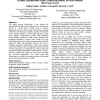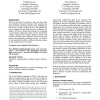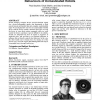6009 search results - page 1125 / 1202 » Design-oriented human-computer interaction |
HUC
2010
Springer
13 years 9 months ago
2010
Springer
This paper presents ElectriSense, a new solution for automatically detecting and classifying the use of electronic devices in a home from a single point of sensing. ElectriSense r...
HUC
2010
Springer
13 years 9 months ago
2010
Springer
We present a study that evaluates the effectiveness of augmenting on-screen instructions with micro-projection for manual task guidance unlike prior work, which replaced screen in...
IUI
2010
ACM
14 years 6 months ago
2010
ACM
We have developed a simulator to help with the design and evaluation of assistive interfaces. The simulator can predict possible interaction patterns when undertaking a task using...
HRI
2009
ACM
14 years 3 months ago
2009
ACM
Several emerging computer devices read bio-electrical signals (e.g., electro-corticographic signals, skin biopotential or facial muscle tension) and translate them into computer- ...
HRI
2009
ACM
14 years 3 months ago
2009
ACM
During conversations, speakers establish their and others’ participant roles (who participates in the conversation and in what capacity)—or “footing” as termed by Goffman�...



